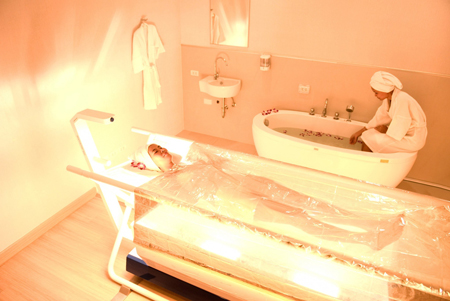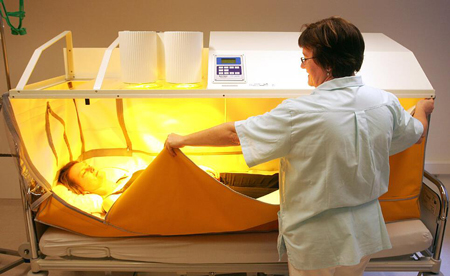Hyperthermia Therapy: Using Heat to Help (I)
“Give me a chance to create a fever and I will cure any disease.” – Parmenides.
The fact that heat in all its forms is good for the body seems to be instinctual knowledge within us. It’s the main reason why people in the colder northern climates flock to warm sunny climes such as California, Florida, the Caribbean, and Spain in wintertime, after all.
But can heat actually heal cancer?

The use of heat for healing has been practiced for millennia. In Ayurveda (the ancient Indian system of healing), a morning bath is said to be an integral part of the daily ritual of self-care, known as dinacharya. The ancient Greeks and Romans understood the importance of warm baths for maintaining vitality. The remains of well-preserved Roman baths can be found in the ruins of many cities including Pompeii and Bath in the UK.
Similarly, many indigenous people continue to utilize sweat lodges as a way to cleanse impurities from the body and the spirit as well as a way to ground themselves to the earth.
In modern times, the use of heat for healing is called hyperthermia therapy. Outside of conventional medicine and even within it, exciting breakthroughs are occurring in the realm of cancer healing through hyperthermia that you should know about.
What Is Hyperthermia?
Healthy people maintain a constant body temperature around 98.6°F or 37°C. Heat is energy, whether it is present in the body, on the surface of the sun, or in a candle flame. Every interaction that occurs in the body does so at a certain level of energy (i.e. temperature). These interactions can be tracked by monitoring pH levels or by measuring cellular voltage.
Body temperature is a part of our basic metabolism. Energy output (i.e. heat output) affects every system and function within the body. As mammals, healthy humans maintain a constant temperature level that ordinarily does not fluctuate much with outside temperature. Our body temperature, normally around 98.6 degrees Fahrenheit (37 degrees Celsius), is ideal for optimal function of all of our body’s physiological systems.
That being said, the fact that there is a whole section about hyperthermia on the website of the National Cancer Institute (NCI) is proof that even conventional medicine cannot deny the serious cancer-healing power of heating the body, either locally or in general, for short periods of time.
According to the NCI, “research has shown that high temperatures can damage and kill cancer cells, usually with minimal injury to normal tissues,” referring to a 2002 study done in the Netherlands that found that temperatures in the 104-111 degrees F range (40-44 degrees C) were deadly to cancer cells.
They also cite a German study published that same year: “…by killing cancer cells and damaging proteins and structures within cells, hyperthermia may shrink tumors.”
It should be noted that both of these studies quoted by the NCI were done within the context of hyperthermia being beneficial as an adjunct to traditional cancer treatments, including chemotherapy and radiation.
Not surprisingly, there is no mention on the NCI website about the awesome power that hyperthermia can play in healing, in and of itself. In fact, the real discoveries in this field have been around how body temperature relates to your immune system and how this relationship can prevent – and even heal – cancer.
For instance, did you know that if your overall body temperature is lowered by just one degree, there is a corresponding decline in immune system function by 40%? According to the groundbreaking research carried out by Dr. Nobuhiro Yoshimizu, creator of the BioMat technologies, the good news is that the opposite is also true. Heating the body boosts the immune system and may help fight diseases like cancer.
How Hyperthermia Treatment Affects Cancer Cells
Some medications will cause a drop in body temperature. There are also many disease conditions that are associated with a lower than normal body temperature as one of their symptoms. These include:
• Hypothyroidism;
• Diabetes;
• Alcoholism;
• Kidney or liver disease or infection;
• Sepsis;
• Shock;
• Asthma;
• Stress;
• Insomnia.
In addition, cancer patients have lower basal body temperatures than those who are cancer-free.

Did you ever wonder why your body overheats and gets a fever when you get the flu or have an infection? According to experts, one reason the body does this is to raise its temperature enough to kill off viruses and bacteria.
Could heating the body through hyperthermia work the same way in regards to destroying cancer tumor cells and preventing them from growing? Hyperthermia therapy not only raises immune system function in general, but an accumulating body of evidence suggests that a more active immune system is the precise catalyst needed for shrinking tumors.
This makes total sense. Cancer tissue must live in an acidic pH environment and raising temperature will raise pH as well, creating an inhospitable environment for cancer cells to grow. A 2013 study published in the journal Cancer Immunology Research was able to pinpoint some precise mechanisms through which heightened temperature can lead to apoptosis or “programmed cell death” in cancer cells.
Researchers found that “hyperthermia impacts the tumor microenvironment through temperature-sensitive check-points that regulate tumor vascular perfusion, lymphocyte trafficking, inflammatory cytokine expression, tumor metabolism, and innate and adaptive immune function.”
Other studies point to the effectiveness of hyperthermia as an adjunct to more traditional cancer therapies. A 2014 study done in Korea found that inducing a hyperthermic condition of 105 degrees F (42 degrees C) was toxic not only to regular breast cancer cells, but breast cancer stem cells as well.
This discovery is particularly significant since it is not possible to eliminate a cancer tumor completely unless its foundational stem cells are removed as well. The study was done as a combination of hyperthermia and the Type 2 diabetes drug Metformin, which has shown (despite some pretty heavy negative side effects) to also be slightly cytotoxic to cancer cells.
Researchers have also discovered that using hyperthermia in conjunction with nanoparticle-enhanced curcumin (the main active ingredient in the south Asian root spice turmeric) instigates cancer cell death.
The concept of heat in the body to create healing is a concept that ancient medicine has known for thousands of years. Modern medicine, on the other hand, is just starting to embrace it. The real significance of conventional studies lies in the increasing evidence of the importance of temperature for the immune response, not so much in the pharmaceutical drugs that a heating environment works well with.
Using Hyperthermia to Help Heal Cancer
If you are considering hyperthermia for healing or preventing cancer, you don’t have to use it in conjunction with dangerous chemotherapy drugs to get a positive result. Here are three powerful ways you can use hyperthermia therapy to prevent – and in some cases, reverse – cancer cell growth:
1. Sauna/Far-Infrared Sauna
An infrared sauna produces radiant energy heat, the same kind of heat as the sun. However, this kind of sauna does not produce harmful ultraviolet rays. Far-infrared heats the body from the inside out. This stimulates the elimination of toxins in two ways – through the lymphatic system and also through sweating.
Sweating in a far-infrared sauna is not just about water, however. Far-infrared sauna therapy is the only detoxification protocol that has proven to release toxins from fat stores in the body. Fat cells are where a lot of the body’s toxic load winds up as it attempts to “encapsulate” these foreign invaders and quarantine them in fatty tissue. Everything from heavy metals to drug and pesticide residue could be housed inside your fatty tissue.
Of course, if done in the proper way, far-infrared therapy also raises the body’s core temperature enough to allow the tumor-shrinking principle of hyperthermia to do its job.
Saunas can be purchased for use in the home. However, far-infrared sauna sessions are typically done in a natural healing or alternative care treatment facility under the supervision of a qualified holistic health practitioner. This protocol is often accompanied by a diet that encourages deep detoxification.
(to be continued)
yogaesoteric
September 21, 2019
Also available in:
 Français
Français
